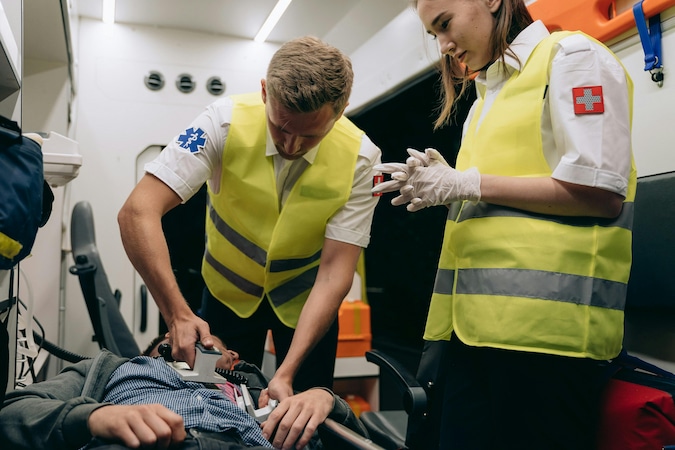
Does Hospital Indemnity Insurance Cover Ambulance Rides?

When facing a medical emergency, ambulance rides can be costly. Does hospital indemnity insurance cover these expenses? Read on to find out.
Hospital indemnity insurance is designed to provide cash benefits for hospital-related expenses. Understanding whether this insurance covers ambulance rides requires a detailed look at policy specifics, including exclusions, emergency classifications, and supplemental options. This guide will clarify how coverage works and how to prepare for unexpected ambulance bills. For more comprehensive health insurance options, visit SelfGood .
Key Takeaways:
- Hospital indemnity insurance often excludes ambulance rides unless specifically covered.
- Emergency medical transportation coverage depends on your policy and optional riders.
- It’s crucial to review your insurance terms and consider supplemental options if needed.
What Is Hospital Indemnity Insurance?

Hospital indemnity insurance provides direct cash benefits to policyholders during hospital stays. Unlike traditional health insurance, it does not pay healthcare providers directly but instead gives you the flexibility to use the funds for medical or non-medical expenses.
Hospital indemnity insurance differs from standard health insurance in several key ways:
- Benefit Structure: You receive a fixed amount per day or event, which you can use at your discretion.
- Supplemental Coverage: This type of insurance acts as a financial buffer to help cover costs not typically paid by traditional health insurance, such as deductibles or lost income.
This flexibility makes hospital indemnity insurance attractive to those wanting extra financial protection during medical emergencies.
Types of Coverage Offered by Hospital Indemnity Insurance
Hospital indemnity insurance covers a variety of hospital-related expenses, including:
- Inpatient Hospital Stays: Fixed cash benefits for each day of hospitalization.
- Surgical Procedures: Some policies provide lump-sum payouts for surgeries.
- Diagnostic Tests: Coverage can extend to certain tests performed during a hospital stay.
Optional Riders and Enhancements: Many policies offer additional coverage through optional riders. These enhancements can include ambulance ride coverage, maternity benefits, or coverage for outpatient treatments. Adding these riders can provide more comprehensive protection but will increase your premiums.
Ambulance Ride Coverage: How It Fits In
The question of whether ambulance rides are covered by hospital indemnity insurance is complex. Generally, standard hospital indemnity plans do not cover ambulance rides unless explicitly stated in the policy. Here’s what you should know:
- Coverage Limitations: Most plans only cover ambulance rides if deemed medically necessary and part of an emergency hospital admission.
- Emergency vs. Non-Emergency Transport: Emergency ambulance rides are more likely to be covered. Non-emergency transport, such as scheduled transfers between facilities, is often excluded.
- Policy Examples: Some insurers may cover ground ambulance services but exclude air ambulances. Always check for maximum payout limits and policy specifics.
- Influencing Factors: The determination of “medically necessary” transportation often depends on your healthcare provider and how the situation is documented.
Understanding these nuances can help you better prepare for unexpected expenses.
Reading the Fine Print: Understanding Policy Exclusions
Policies vary significantly, and exclusions are common. Here’s what to consider:
- Common Exclusions: Non-emergency ambulance rides, transportation without pre-authorization, and air ambulances are typically excluded.
- Why You Must Read the Fine Print: Failing to understand your policy can lead to costly surprises. Exclusions are often hidden in complex policy language.
- Tips for Policy Review: Seek clarification from your insurance agent, especially on terms like “medically necessary” and “emergency transportation.” This will prevent misunderstandings and unexpected expenses.
How to Determine If Your Policy Covers Ambulance Rides

Follow these steps to determine your coverage:
- Examine Your Policy: Search for keywords like “ambulance,” “emergency transport,” and “coverage limits.” Ensure you understand what is included and excluded.
- Contact Your Insurance Provider: Ask pointed questions, such as “Is there a cap on ambulance ride coverage?” or “Are both ground and air ambulances covered?”
- Coverage Scenarios: For example, if you experience a medical emergency and your healthcare provider deems the ambulance ride necessary, your policy is more likely to cover the expense. Non-emergency rides, even if medically advised, may not be eligible.
By understanding these details, you can make informed decisions about your healthcare and financial protection.
Factors Affecting Ambulance Ride Coverage
Several variables influence whether an ambulance ride will be covered:
- Geographic Differences: Coverage may vary by state due to differing regulations.
- Nature of the Transport: Emergency rides are prioritized for coverage, while non-emergency transports are often denied.
- Provider Influence: A healthcare provider’s documentation can impact whether your ride is considered medically necessary, influencing the likelihood of insurance reimbursement.
Being aware of these factors can help you better navigate your insurance options.
Additional Coverage Options for Ambulance Rides
If your hospital indemnity insurance does not cover ambulance rides, consider these alternatives:
- Supplemental Insurance: Critical illness or accident insurance may cover ambulance services.
- Optional Riders: Adding a rider for ambulance coverage can provide peace of mind but comes at a higher cost.
- Cost-Benefit Analysis: Weigh the potential expense of an ambulance ride against the premium increase from adding supplemental coverage. This can help you decide if it’s worth the investment.
Final Thoughts
Navigating hospital indemnity insurance can be challenging, especially when it comes to understanding ambulance ride coverage. Reviewing your policy, asking questions, and considering supplemental options can prepare you for unexpected medical emergencies. Always consult your insurance provider to clarify your benefits and ensure you have the protection you need.
Frequently Asked Questions
Does hospital indemnity insurance cover all types of ambulance rides?
Coverage often depends on the policy. Typically, only medically necessary emergency ambulance rides are covered, while non-emergency or scheduled transports are excluded.
What happens if the ambulance ride isn’t deemed medically necessary?
If the ride isn’t considered medically necessary by your provider or insurance, you may be responsible for the full cost. Always check with your insurance beforehand if possible.
Are air ambulance services covered under hospital indemnity insurance?
Air ambulance services are generally not covered unless explicitly stated in your policy or added as an optional rider. Always verify with your insurance provider.
Sources:
- Medicare.gov. (n.d.).Ambulance services coverage. Retrieved from Medicare.gov
- Healthcare.gov. (n.d.).Health insurance basics and supplemental plans. Retrieved from Healthcare.gov
- National Association of Insurance Commissioners (NAIC). (n.d.). Reviewing insurance policies. Retrieved from NAIC



